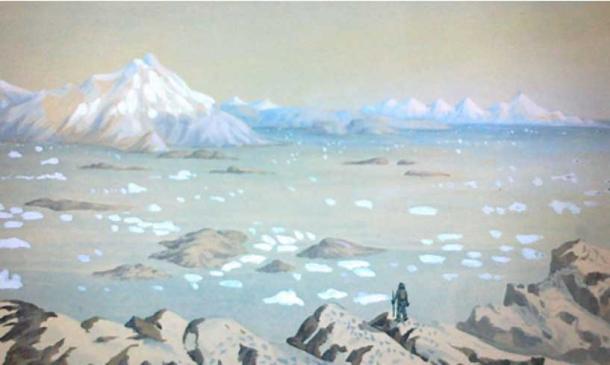Did This Ancient Explorer Make It to The Arctic In 325 BC?
The first arctic explorer isn’t who you think. More than 2,300 years ago, Pytheas of Massalia traveled to the Arctic Circle and back – and, when he came home, nobody believed him.
In a time when most people believed that the sun was dragged across the sky by a god, Pytheas made it to a place where the sun doesn’t rise all winter long. He found a place covered in permafrost, a frozen ocean, and drifting icebergs, and he had to come home and try to explain what he’d seen.
He made discoveries so incredible that they were literally unbelievable – and it took more than a thousand years before we found out he was telling the truth.

An explorer in the Arctic by Andreas Kornerup (CC by SA 2.0)
Who Was Pytheas?
Not much is known about Pytheas’s life. He was, we are told, “a poor man”, who traveled north on his own dime, without the support of any government. Everything beyond that, though, is speculation. Every word he wrote has been lost to time, and what we know of his journey comes, mainly, from people who didn’t believe him.

Statue of Pythéas by Auguste Ottin (1811-1890) in front of the Exchange in Marseille (CC by SA 3.0)
It’s easy to understand why the ancient world would have doubted that a poor sailor could have made the trip Pytheas made. The path north took him through the Strait of Gibraltar, a place the ancient world called the Pillars of Hercules. To get through it, he had to get past a military blockade held by the Carthaginian army.
Somehow, Pytheas and his crew snuck past an entire army – although nobody knows for sure how he did it. Modern historians have their theories, but they’re really nothing more than wild speculation. And the only explanation the ancient world left us was that Pytheas was a liar and none of it ever really happened.
The things he reported back, though, suggest that, somehow, he really did it. Somehow, snuck past an army, went on to Britain and – once there – became the person to circumnavigate the island. And he was only getting started.

The Strait of Gibraltar (public domain)
The Discovery of Thule
After circling Britain, Pytheas went on north, in search of an undiscovered land the natives promised him was out there. This went against all reason – at the time, it was believed that there was nothing north of Britain but ocean. Pytheas’ trip would take him past the edge of the world.
After six days of sailing, he saw, jutting out of the water, the tall, rocky coastline of a land he called Thule. Nobody knows for sure what country he discovered – it may have been Iceland or Norway. It would be more than a thousand years before any European attempted the trip again.
His records of the sky, though, suggest he really was somewhere near the Arctic Circle. He recorded how the stars overhead shifted, and they reflect the sky you’d actually see from around Iceland. And he recorded how much shorter the days became as he traveled north.
He claims that there were people living there when he arrived – which, if Thule is Iceland, would be incredible, as the country was deserted when it was colonized 1000 years after his journey. These people, he said, had to struggle to live in a place where the sun barely shone and few plants and animals could live. They lived off millet, fruit, and roots, unable to grow much else.
“There is no night at the summer solstice,” Pytheas reported back from Thule. This, for a person living in the 4 th century BC, must have been an incredible revelation. He was seeing something that no Greek had ever seen – a place where the sun didn’t rise all winter long.

A 16 th century map of the Arctic (public domain)
The Frozen Ocean
Pytheas had gone further north than any European had ever traveled – but he didn’t stop there. He sailed on, a day’s journey north of Thule, and reached a place he didn’t know how to describe. There was something in the water which he said was not “land properly so‑called, or sea, or air, but a kind of substance concreted from all these elements, resembling a sea-lungs.”
It’s believed, today, that he was trying to describe a sea filled with drifting pancake ice. With no frame of reference to describe it, though, he had to resort to some strange word choices. He called it a “jellyfish-like substance”, which “you can neither walk nor sail upon”.
Blocked by a frozen ocean, Pytheas was forced to turn back. He had already seen things that most people couldn’t even imagine. He’d traveled from the Mediterranean up past the Arctic Circle to a place enveloped in darkness, a place where the very ocean was frozen over.
Doubted In His Own Time
When he returned, hardly anyone believed him. Our best source for his journey is Strabo, a man who hated him so much he couldn’t even write his name without hurling a few insults his way. When he writes his name, he calls him, “Pytheas, who misleads people everywhere”, or “Pytheas, by whom many have been misled”. At another part, he jokes that asking Pytheas not to lie is like asking a juggler not to juggle.
Iceland wouldn’t be colonized until 800 AD, and the age of exploration wouldn’t come begin until 1400 AD. No European would see what Pytheas saw for over a thousand years.
It would another thousand years before anyone believed him. Today, modern historians have compared his writing to what we know today, and have realized that he described things about the arctic that no Greek who’d never been there could have known.
More than two thousand years after he died, Pytheas has been vindicated. Most historians now believe he was telling the truth – but he would go to his grave treated like a liar, unable to convince the world of what he’d seen.
Top image: Illustration representing an ancient explorer.
By Mark Oliver
References
Pliny the Elder, The Natural History. Translated by John Bostock. London: Taylor and Francis. 1855. http://www.perseus.tufts.edu/hopper/text?doc=Perseus%3Atext%3A1999.02.0137%3Abook%3D4%3Achapter%3D1
Hafstad, Vala. “Major Archaeological Find in Iceland”. Iceland Review Online. October 2, 2016. http://icelandreview.com/news/2016/09/15/major-archaeological-find-iceland
McCaskill, Eloise. “Pytheas”. Encylopedia Arctica. Dartmouth College Library. 1951. http://collections.dartmouth.edu/arctica-beta/html/EA15-57.html
Strabo. Geography. Translated by H. L. Jones. Harvard University Press. 1917. http://penelope.uchicago.edu/Thayer/E/Roman/Texts/Strabo/home.html


















Comments
Years ago I met an archaeology doctoral student and museum curator in Buffalo who was excavating in Iceland. He spoke of evidence of inhabitants in Iceland below many sterile (re human human evidence) metres below "modern' material. I regrettably forget his name, and my friend who know him died some years ago. It would not surprise me he got there - after all who took him - someone who knew how to get there - surely not because of a poor man's whim? It was known from migrating birds that there must be land to the north of Ireland and Scotland.
he could have been there for only one winter season and experienced no sun rise while he was there and saw an environment that led him to believe that the current winter was typical...
If Pytheas sailed north to a place where there is no night, he sailed to a place where the sun never sets in summer, and not to a place where the sun never rises in winter. He could only have known it doesn't if he stayed there a whole year. Is there evidence to that effect?
Normann, your first statement is false, there were a few people in Greenland by 325 BC and the country didn't stayed empty until the 10th century AD.
There is some undeniable archeological evidences that the ameridindian Dorset culture had settlement in Greenland from as early as 600 BC until as late as 1000 AD.
However, those settlements were all on the northwest coast of Greenland, so even if Pytheas had reached Greenland, it would have been from the opposite southeast side and he would then have found an empty land, so that only leaves the scandinavian peninsula as possible solution.
There wasn't anyone in Greenland in 325 BC. The first humans arrived about 2500 BC but died out. The country was empty until the 10th century AD, when it was settled by Norsemen. The Inuit who live there now only arrived about 200 years later. Pytheas discovered the Scandinavian peninsula (Thule) which was believed to be an island. No other land fits the description.
Pages